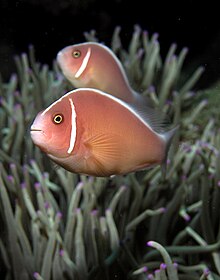Clownfish or anemonefish are fishes from the subfamily Amphiprioninae in the family Pomacentridae. About twenty-nine species are recognized, one in the genus Premnas, while the remaining are in the genus Amphiprion. In the wild they all form symbiotic mutualisms with sea anemones. Depending on species, clownfish are overall yellow, orange, reddish, or blackish, and many show white bars or patches. The largest can reach a length of 18 centimetres (7.1 in), while some can be as small as 10 centimetres
| Clownfish | |
|---|---|
 | |
| Ocellaris clownfish, Amphiprion ocellaris | |
| Scientific classification | |
| Kingdom: | Animalia |
| Phylum: | Chordata |
| Class: | Actinopterygii |
| Order: | Perciforlmes |
| Family: | Pomacentridae |
| Subfamily: | Amphiprioninae |
Ecology and habitat
Clownfish are native to warmer waters of the Indian and Pacific oceans, including the Great Barrier Reef and the Red Sea. While most species have restricted distributions, others are widespread. They are generally highly host specific, and especially the genera Heteractis and Stichodactyla, and the species Entacmaea quadricolor are frequent partners. The clownfish feeds on small invertebrates which otherwise potentially could harm the sea anemone, and the fecal matter from the clownfish provides nutrients to the sea anemone. Clownfish are omnivores. Algae accounts for around 20 to 25 percent of its diet in the wild (and should also account for its amount of algae diet in captivity as well). It has also been suggested that the activity of the clownfish results in greater water circulation around the sea anemone. In addition to providing food for the clownfish, the sea anemone also provides safety due to its poison.
Clownfish and certain damselfish are the only species of fishes that can avoid the potent poison of a sea anemone. There are several theories about how this is accomplished:
- The mucus coating of the fish may be based on sugars rather than proteins. This would mean that anemones fail to recognize the fish as a potential food source and do not fire their nematocysts, or sting organelles.
- The coevolution of certain species of clownfish with specific anemone host species and may have acquired an immunity to the nematocysts and toxins of their host anemone. Experimentation has shown that Amphiprion percula may develop resistance to the toxin from Heteractis magnifica, but it is not totally protected, since it was shown experimentally to die when its skin, devoid of mucus, was exposed to the nematocysts of its host.[1]
 A pair of pink anemonefish (Amphiprion perideraion) in their anemone home.
A pair of pink anemonefish (Amphiprion perideraion) in their anemone home.
Clownfish live in small groups inhabiting a single anemone. The group consists of a breeding pair, which cohabit with a few non-reproductive, "pre-pubescent", and smaller male clownfish. When the female dies, the dominant male changes sex and becomes the female.[2] This life history strategy is known as sequential hermaphroditism. Because clownfish are all born as males, they are protandrous hermaphrodites (pro=first; androus=male).[3]
Clownfish lay eggs on any flat surface close to their host anemones. In the wild, clownfish spawn around the time of the full moon and the male parent guards them until they hatch about 6 to 10 days later, typically 2 hours after dusk.[citation needed] Clownfish are omnivorous: in the wild they eat live food such as algae, plankton, molluscs, and crustacea; in captivity they can survive on live food, fish flakes, and fish pellets. They feed mostly on copepods and mysids, and undigested food from their host anemones.[citation needed]
Depending on the species, clownfish can lay hundreds or thousands of eggs. Clownfish were the first type of marine ornamental fish to be successfully bred in captivity on a large scale. It is one of a handful of marine ornamentals whose complete life cycle has been closed in captivity. Members of some clownfish species, such as the maroon clownfish, become aggressive in captivity; others, like the false percula clownfish, can be kept successfully with other individuals of the same
In the aquarium

Clownfish are now reared in captivity by a handful of marine ornamental farms in the USA, Clown fish were the first species of Saltwater fish to successfully be Tank-raised. Tank-raised fish are a better choice for aquarist, because wild-caught fish are more likely to die soon after purchasing them due to the stress of capture and shipping. Also, tank-bred fish are usually more disease resistant and in general are less affected by stress when introduced to the aquarium. Captive bred clownfishes may not have the same instinctual behavior to live in an anemone. They may have to be coaxed into finding the anemone by the home aquarist. Even then, there is no guarantee that the anemone will host the clownfish.
When a sea anemone is not available in an aquarium, the clownfish may settle in some varieties of soft corals, or large polyp stony corals. If the fish settles in a coral, it could agitate the fish's skin, and, in some cases, may kill the coral. Once an anemone or coral has been adopted, the clownfish will defend it. As there is less pressure to forage for food in an aquarium, it is common for clownfish to remain within 2-4 inches of their host for an entire lifetime.
 RSS Feed
RSS Feed Twitter
Twitter 9:03 PM
9:03 PM
 Your All Kinds Of Need At One Place
Your All Kinds Of Need At One Place
0 comments:
Post a Comment